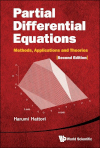- About MAA
- Membership
- MAA Publications
- Periodicals
- Blogs
- MAA Book Series
- MAA Press (an imprint of the AMS)
- MAA Notes
- MAA Reviews
- Mathematical Communication
- Information for Libraries
- Author Resources
- Advertise with MAA
- Meetings
- Competitions
- Programs
- Communities
- MAA Sections
- SIGMAA
- MAA Connect
- Students
- MAA Awards
- Awards Booklets
- Writing Awards
- Teaching Awards
- Service Awards
- Research Awards
- Lecture Awards
- Putnam Competition Individual and Team Winners
- D. E. Shaw Group AMC 8 Awards & Certificates
- Maryam Mirzakhani AMC 10 A Awards & Certificates
- Two Sigma AMC 10 B Awards & Certificates
- Jane Street AMC 12 A Awards & Certificates
- Akamai AMC 12 B Awards & Certificates
- High School Teachers
- News
You are here
Partial Differential Equations

Publisher:
World Scientific
Publication Date:
2019
Number of Pages:
426
Format:
Hardcover
Edition:
2nd
Price:
88.00
ISBN:
978-9811202230
Category:
Textbook
[Reviewed by , on ]
Pierre-Olivier Parisé
07/24/2021
The book under review, Partial Differential Equations : Methods, Applications and Theories is intended for a university-level course on PDEs. It contains 12 chapters which can be covered in a one semester course. It is intended to present the main tools used in PDEs in view of studying more advanced subjects from other disciplines.
Within the 12 chapters, the author presents the three famous partial differential equations (PDEs): the heat, wave and Laplace equations. He then uses these basic models to illustrate the methods and theory in solving PDEs such as the superposition principle, the method of characteristics, the method of separation of variables, the energy methods, the maximum principles, the method of descent, Green’s function, the fundamental solutions, etc.
The author also presents a great treatment of the method of separation of variables in several variables focusing on rectangular, circular, cylindrical and spherical domains. The author presents a lot of examples to show how the method works in these circumstances and what types of changes are necessary to ensure that everything works properly. In particular, the Bessel and the modified Bessel functions are presented to deal with the circular and cylindrical domains.
The Fourier and Laplace transforms are also presented and the author shows how to use these transforms to solve PDEs. He also presents some elements of the theory of distributions, but it is rather concise and serves only to support the introduction of the delta function. A more thorough treatment of these notions is presented in the well-known book Partial Differential Equations by Evans. I would recommend Evans’s book because the proofs are presented more rigorously than the book under review and the subject is presented in greater depth.
Finally, the author presents interesting applications of PDEs in many areas of science. The first application is in fluid dynamics and the author presents the Burgers’ equation. The second application is in finance, and the author presents the Black-Scholes-Merton’s equation.
The book presents many examples to show how to apply the theory and there are many exercises with partial solutions at the end of the book. It is the strength of the book and I would recommend it to any teacher who needs good examples to present to his classroom. However, there is redundancy in the content of the book. For example, the method of characteristics is presented three times in the book for linear, quasi-linear and nonlinear equations. In addition, the contents of the book are not correctly structured. Fourier series are fully presented only after the chapter on the method of separation of variables. This makes it difficult to follow and to understand the method. The book also contains several grammatical mistakes and typographical errors.
Overall the book is a great reference for any teacher who needs examples to present to his classroom. I think the author should emphasize this aspect of the book and make it clear in his Preface. This would enhance the place of the book on the current market.
Pierre-Olivier Parisé got his PhD from Laval University under the supervision of Thomas J. Ransford. His thesis, Summability of the Taylor series in Banach Spaces of Holomorphic Functions, focused on applications of summability methods to the convergence of the Taylor series in various spaces of holomorphic functions. He was recently hired as a Temporary Assistant Professor at the University of Hawaii at Manoa (UHM) and also received a post-doctoral scholarship from the FRQNT to work alongside Malik Younsi at UHM.
See the publisher's website.
- Log in to post comments




